Food & Beverage Industry Report: Operational & Marketing Strategies
VerifiedAdded on 2023/01/16
|12
|3862
|99
Report
AI Summary
This report provides a comprehensive analysis of the food and beverage (F&B) industry. It begins by outlining the various types of businesses within the sector, including food and beverage establishments, accommodation and lodging, and entertainment venues, emphasizing their roles in business growth and customer satisfaction. The report then delves into different rating systems used in the industry, such as one-star to five-star ratings, and their implications for service quality and customer expectations. Furthermore, it addresses current and upcoming trends influencing the F&B sector, including the impact of technology, mergers and acquisitions, and changing consumer preferences. The report also explores the professional skills needed in the F&B business, such as organizational, customer service, and communication skills, and examines legal and regulatory requirements, including food safety regulations. The discussion extends to operational and marketing technologies adopted in the sector. Finally, the report examines factors influencing consumer decision-making and strategies for attracting and retaining customers, providing a holistic view of the F&B industry's operations and strategic approaches.
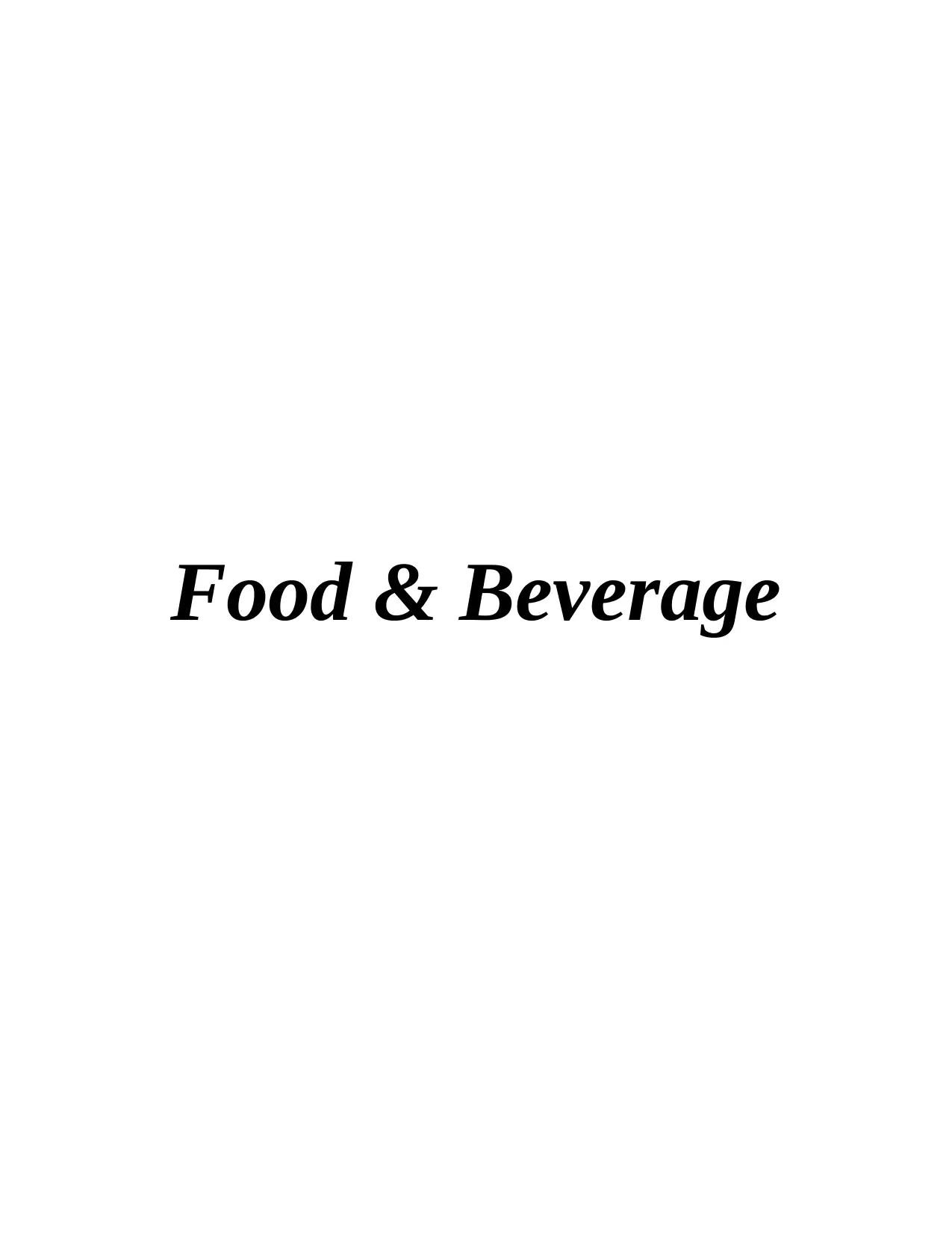
Food & Beverage
Paraphrase This Document
Need a fresh take? Get an instant paraphrase of this document with our AI Paraphraser
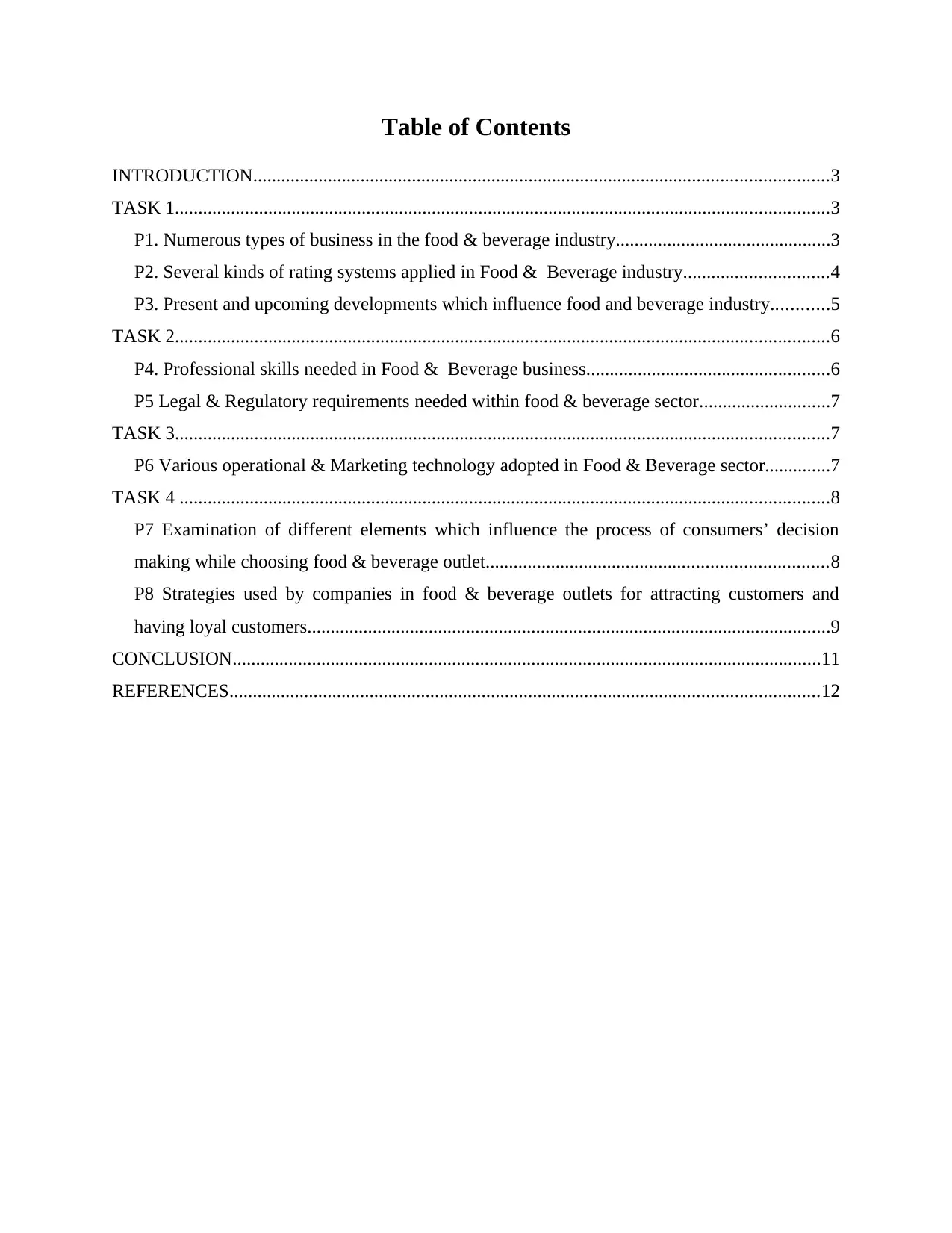
Table of Contents
INTRODUCTION...........................................................................................................................3
TASK 1............................................................................................................................................3
P1. Numerous types of business in the food & beverage industry..............................................3
P2. Several kinds of rating systems applied in Food & Beverage industry...............................4
P3. Present and upcoming developments which influence food and beverage industry............5
TASK 2............................................................................................................................................6
P4. Professional skills needed in Food & Beverage business....................................................6
P5 Legal & Regulatory requirements needed within food & beverage sector............................7
TASK 3............................................................................................................................................7
P6 Various operational & Marketing technology adopted in Food & Beverage sector..............7
TASK 4 ...........................................................................................................................................8
P7 Examination of different elements which influence the process of consumers’ decision
making while choosing food & beverage outlet.........................................................................8
P8 Strategies used by companies in food & beverage outlets for attracting customers and
having loyal customers................................................................................................................9
CONCLUSION..............................................................................................................................11
REFERENCES..............................................................................................................................12
INTRODUCTION...........................................................................................................................3
TASK 1............................................................................................................................................3
P1. Numerous types of business in the food & beverage industry..............................................3
P2. Several kinds of rating systems applied in Food & Beverage industry...............................4
P3. Present and upcoming developments which influence food and beverage industry............5
TASK 2............................................................................................................................................6
P4. Professional skills needed in Food & Beverage business....................................................6
P5 Legal & Regulatory requirements needed within food & beverage sector............................7
TASK 3............................................................................................................................................7
P6 Various operational & Marketing technology adopted in Food & Beverage sector..............7
TASK 4 ...........................................................................................................................................8
P7 Examination of different elements which influence the process of consumers’ decision
making while choosing food & beverage outlet.........................................................................8
P8 Strategies used by companies in food & beverage outlets for attracting customers and
having loyal customers................................................................................................................9
CONCLUSION..............................................................................................................................11
REFERENCES..............................................................................................................................12
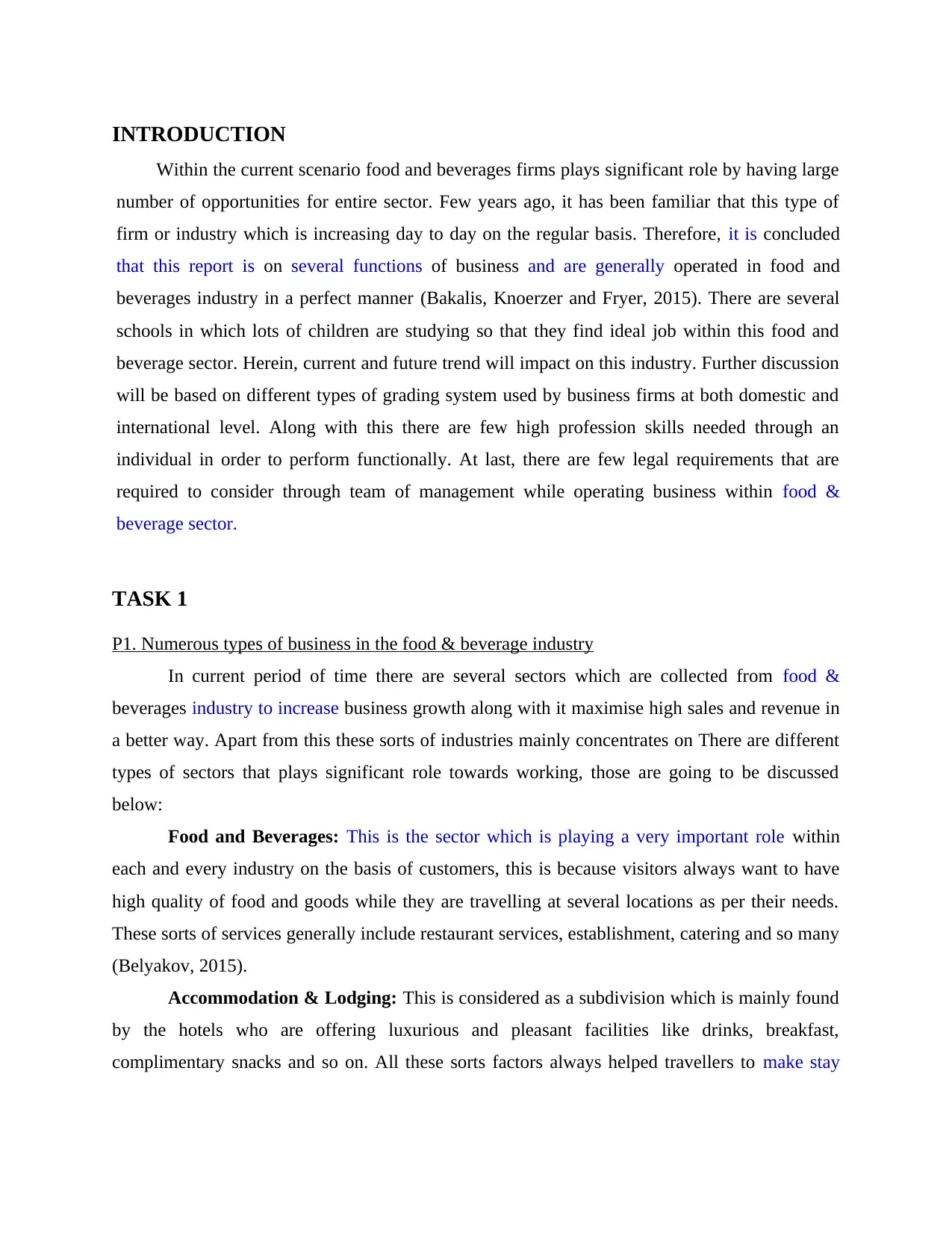
INTRODUCTION
Within the current scenario food and beverages firms plays significant role by having large
number of opportunities for entire sector. Few years ago, it has been familiar that this type of
firm or industry which is increasing day to day on the regular basis. Therefore, it is concluded
that this report is on several functions of business and are generally operated in food and
beverages industry in a perfect manner (Bakalis, Knoerzer and Fryer, 2015). There are several
schools in which lots of children are studying so that they find ideal job within this food and
beverage sector. Herein, current and future trend will impact on this industry. Further discussion
will be based on different types of grading system used by business firms at both domestic and
international level. Along with this there are few high profession skills needed through an
individual in order to perform functionally. At last, there are few legal requirements that are
required to consider through team of management while operating business within food &
beverage sector.
TASK 1
P1. Numerous types of business in the food & beverage industry
In current period of time there are several sectors which are collected from food &
beverages industry to increase business growth along with it maximise high sales and revenue in
a better way. Apart from this these sorts of industries mainly concentrates on There are different
types of sectors that plays significant role towards working, those are going to be discussed
below:
Food and Beverages: This is the sector which is playing a very important role within
each and every industry on the basis of customers, this is because visitors always want to have
high quality of food and goods while they are travelling at several locations as per their needs.
These sorts of services generally include restaurant services, establishment, catering and so many
(Belyakov, 2015).
Accommodation & Lodging: This is considered as a subdivision which is mainly found
by the hotels who are offering luxurious and pleasant facilities like drinks, breakfast,
complimentary snacks and so on. All these sorts factors always helped travellers to make stay
Within the current scenario food and beverages firms plays significant role by having large
number of opportunities for entire sector. Few years ago, it has been familiar that this type of
firm or industry which is increasing day to day on the regular basis. Therefore, it is concluded
that this report is on several functions of business and are generally operated in food and
beverages industry in a perfect manner (Bakalis, Knoerzer and Fryer, 2015). There are several
schools in which lots of children are studying so that they find ideal job within this food and
beverage sector. Herein, current and future trend will impact on this industry. Further discussion
will be based on different types of grading system used by business firms at both domestic and
international level. Along with this there are few high profession skills needed through an
individual in order to perform functionally. At last, there are few legal requirements that are
required to consider through team of management while operating business within food &
beverage sector.
TASK 1
P1. Numerous types of business in the food & beverage industry
In current period of time there are several sectors which are collected from food &
beverages industry to increase business growth along with it maximise high sales and revenue in
a better way. Apart from this these sorts of industries mainly concentrates on There are different
types of sectors that plays significant role towards working, those are going to be discussed
below:
Food and Beverages: This is the sector which is playing a very important role within
each and every industry on the basis of customers, this is because visitors always want to have
high quality of food and goods while they are travelling at several locations as per their needs.
These sorts of services generally include restaurant services, establishment, catering and so many
(Belyakov, 2015).
Accommodation & Lodging: This is considered as a subdivision which is mainly found
by the hotels who are offering luxurious and pleasant facilities like drinks, breakfast,
complimentary snacks and so on. All these sorts factors always helped travellers to make stay
⊘ This is a preview!⊘
Do you want full access?
Subscribe today to unlock all pages.

Trusted by 1+ million students worldwide
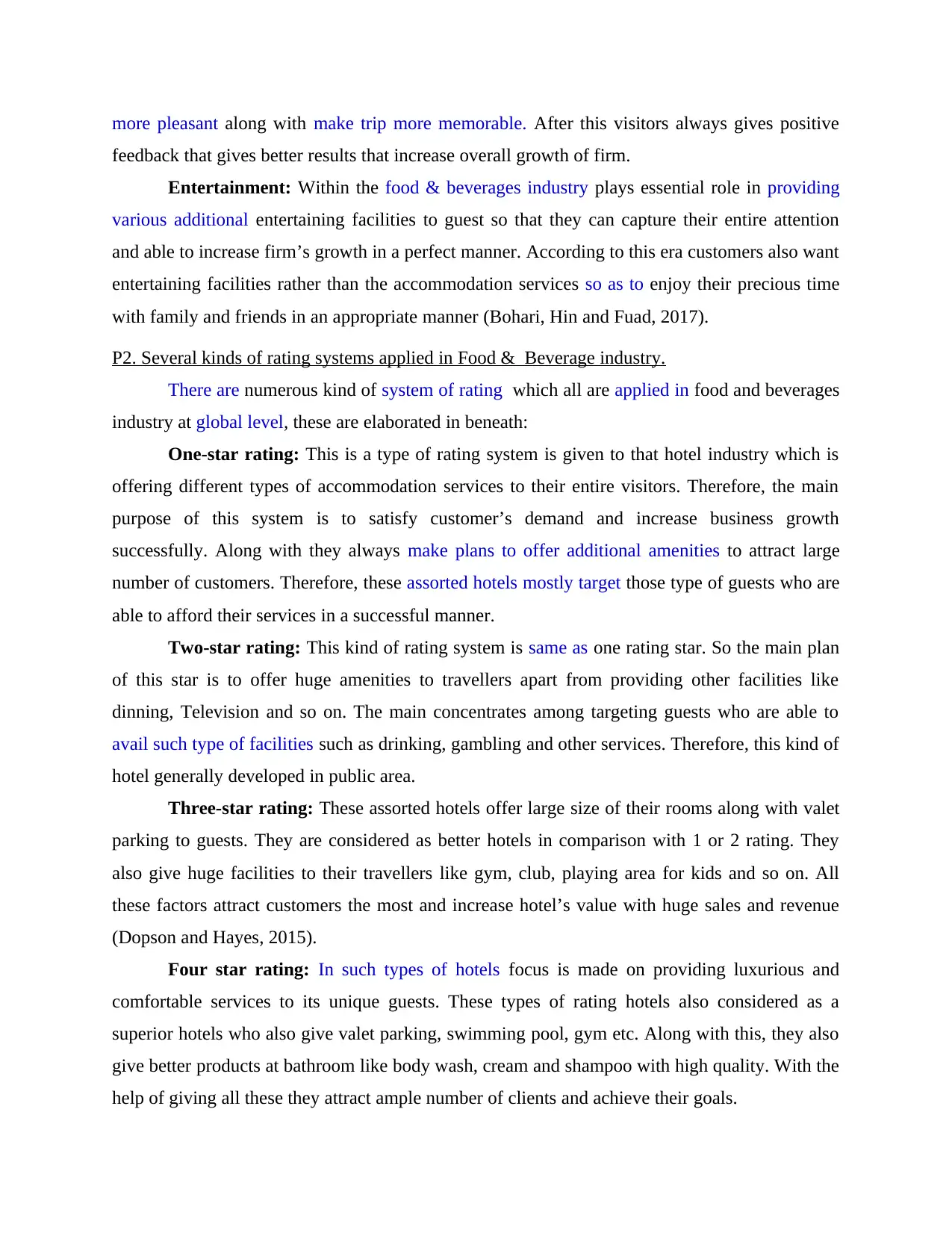
more pleasant along with make trip more memorable. After this visitors always gives positive
feedback that gives better results that increase overall growth of firm.
Entertainment: Within the food & beverages industry plays essential role in providing
various additional entertaining facilities to guest so that they can capture their entire attention
and able to increase firm’s growth in a perfect manner. According to this era customers also want
entertaining facilities rather than the accommodation services so as to enjoy their precious time
with family and friends in an appropriate manner (Bohari, Hin and Fuad, 2017).
P2. Several kinds of rating systems applied in Food & Beverage industry.
There are numerous kind of system of rating which all are applied in food and beverages
industry at global level, these are elaborated in beneath:
One-star rating: This is a type of rating system is given to that hotel industry which is
offering different types of accommodation services to their entire visitors. Therefore, the main
purpose of this system is to satisfy customer’s demand and increase business growth
successfully. Along with they always make plans to offer additional amenities to attract large
number of customers. Therefore, these assorted hotels mostly target those type of guests who are
able to afford their services in a successful manner.
Two-star rating: This kind of rating system is same as one rating star. So the main plan
of this star is to offer huge amenities to travellers apart from providing other facilities like
dinning, Television and so on. The main concentrates among targeting guests who are able to
avail such type of facilities such as drinking, gambling and other services. Therefore, this kind of
hotel generally developed in public area.
Three-star rating: These assorted hotels offer large size of their rooms along with valet
parking to guests. They are considered as better hotels in comparison with 1 or 2 rating. They
also give huge facilities to their travellers like gym, club, playing area for kids and so on. All
these factors attract customers the most and increase hotel’s value with huge sales and revenue
(Dopson and Hayes, 2015).
Four star rating: In such types of hotels focus is made on providing luxurious and
comfortable services to its unique guests. These types of rating hotels also considered as a
superior hotels who also give valet parking, swimming pool, gym etc. Along with this, they also
give better products at bathroom like body wash, cream and shampoo with high quality. With the
help of giving all these they attract ample number of clients and achieve their goals.
feedback that gives better results that increase overall growth of firm.
Entertainment: Within the food & beverages industry plays essential role in providing
various additional entertaining facilities to guest so that they can capture their entire attention
and able to increase firm’s growth in a perfect manner. According to this era customers also want
entertaining facilities rather than the accommodation services so as to enjoy their precious time
with family and friends in an appropriate manner (Bohari, Hin and Fuad, 2017).
P2. Several kinds of rating systems applied in Food & Beverage industry.
There are numerous kind of system of rating which all are applied in food and beverages
industry at global level, these are elaborated in beneath:
One-star rating: This is a type of rating system is given to that hotel industry which is
offering different types of accommodation services to their entire visitors. Therefore, the main
purpose of this system is to satisfy customer’s demand and increase business growth
successfully. Along with they always make plans to offer additional amenities to attract large
number of customers. Therefore, these assorted hotels mostly target those type of guests who are
able to afford their services in a successful manner.
Two-star rating: This kind of rating system is same as one rating star. So the main plan
of this star is to offer huge amenities to travellers apart from providing other facilities like
dinning, Television and so on. The main concentrates among targeting guests who are able to
avail such type of facilities such as drinking, gambling and other services. Therefore, this kind of
hotel generally developed in public area.
Three-star rating: These assorted hotels offer large size of their rooms along with valet
parking to guests. They are considered as better hotels in comparison with 1 or 2 rating. They
also give huge facilities to their travellers like gym, club, playing area for kids and so on. All
these factors attract customers the most and increase hotel’s value with huge sales and revenue
(Dopson and Hayes, 2015).
Four star rating: In such types of hotels focus is made on providing luxurious and
comfortable services to its unique guests. These types of rating hotels also considered as a
superior hotels who also give valet parking, swimming pool, gym etc. Along with this, they also
give better products at bathroom like body wash, cream and shampoo with high quality. With the
help of giving all these they attract ample number of clients and achieve their goals.
Paraphrase This Document
Need a fresh take? Get an instant paraphrase of this document with our AI Paraphraser
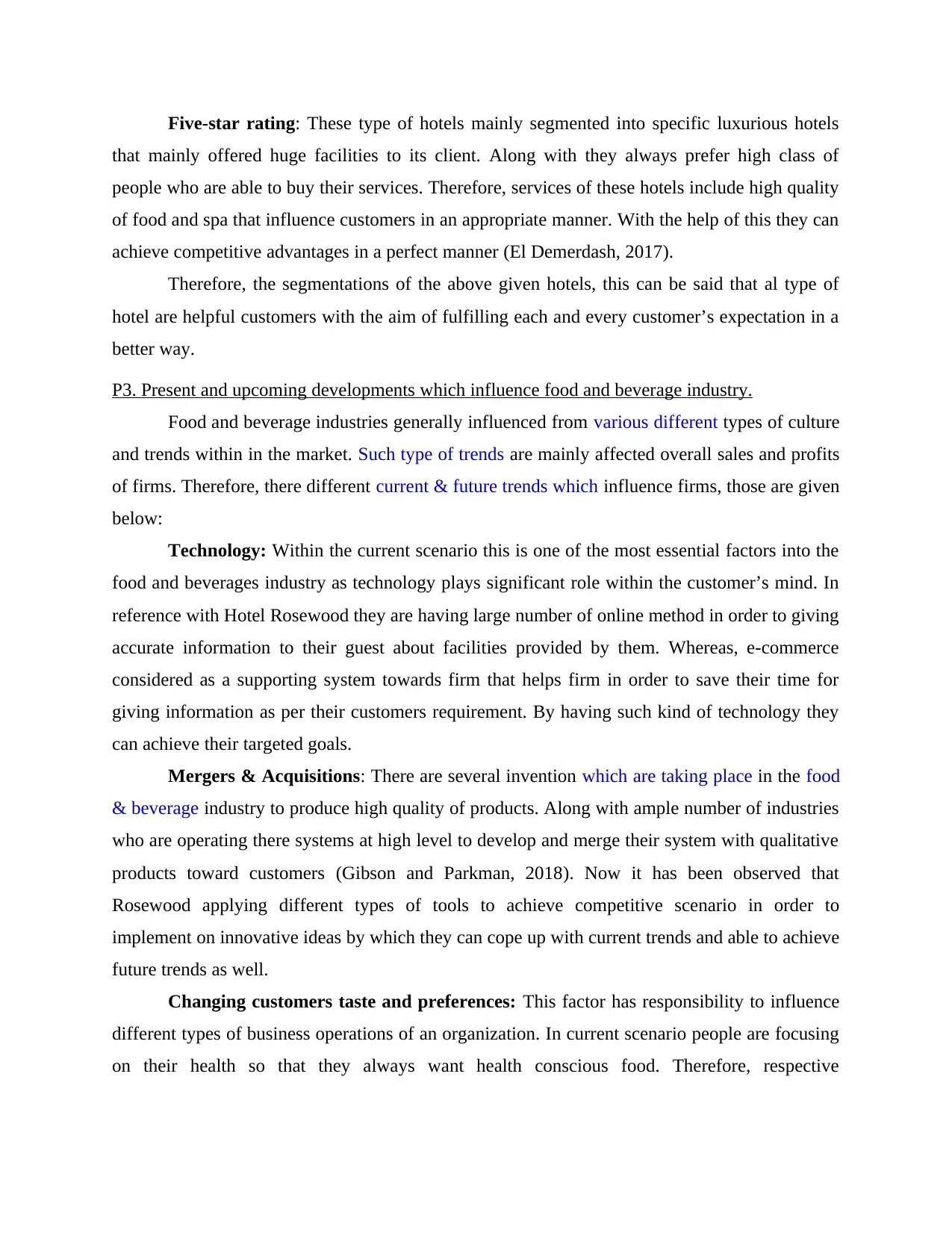
Five-star rating: These type of hotels mainly segmented into specific luxurious hotels
that mainly offered huge facilities to its client. Along with they always prefer high class of
people who are able to buy their services. Therefore, services of these hotels include high quality
of food and spa that influence customers in an appropriate manner. With the help of this they can
achieve competitive advantages in a perfect manner (El Demerdash, 2017).
Therefore, the segmentations of the above given hotels, this can be said that al type of
hotel are helpful customers with the aim of fulfilling each and every customer’s expectation in a
better way.
P3. Present and upcoming developments which influence food and beverage industry.
Food and beverage industries generally influenced from various different types of culture
and trends within in the market. Such type of trends are mainly affected overall sales and profits
of firms. Therefore, there different current & future trends which influence firms, those are given
below:
Technology: Within the current scenario this is one of the most essential factors into the
food and beverages industry as technology plays significant role within the customer’s mind. In
reference with Hotel Rosewood they are having large number of online method in order to giving
accurate information to their guest about facilities provided by them. Whereas, e-commerce
considered as a supporting system towards firm that helps firm in order to save their time for
giving information as per their customers requirement. By having such kind of technology they
can achieve their targeted goals.
Mergers & Acquisitions: There are several invention which are taking place in the food
& beverage industry to produce high quality of products. Along with ample number of industries
who are operating there systems at high level to develop and merge their system with qualitative
products toward customers (Gibson and Parkman, 2018). Now it has been observed that
Rosewood applying different types of tools to achieve competitive scenario in order to
implement on innovative ideas by which they can cope up with current trends and able to achieve
future trends as well.
Changing customers taste and preferences: This factor has responsibility to influence
different types of business operations of an organization. In current scenario people are focusing
on their health so that they always want health conscious food. Therefore, respective
that mainly offered huge facilities to its client. Along with they always prefer high class of
people who are able to buy their services. Therefore, services of these hotels include high quality
of food and spa that influence customers in an appropriate manner. With the help of this they can
achieve competitive advantages in a perfect manner (El Demerdash, 2017).
Therefore, the segmentations of the above given hotels, this can be said that al type of
hotel are helpful customers with the aim of fulfilling each and every customer’s expectation in a
better way.
P3. Present and upcoming developments which influence food and beverage industry.
Food and beverage industries generally influenced from various different types of culture
and trends within in the market. Such type of trends are mainly affected overall sales and profits
of firms. Therefore, there different current & future trends which influence firms, those are given
below:
Technology: Within the current scenario this is one of the most essential factors into the
food and beverages industry as technology plays significant role within the customer’s mind. In
reference with Hotel Rosewood they are having large number of online method in order to giving
accurate information to their guest about facilities provided by them. Whereas, e-commerce
considered as a supporting system towards firm that helps firm in order to save their time for
giving information as per their customers requirement. By having such kind of technology they
can achieve their targeted goals.
Mergers & Acquisitions: There are several invention which are taking place in the food
& beverage industry to produce high quality of products. Along with ample number of industries
who are operating there systems at high level to develop and merge their system with qualitative
products toward customers (Gibson and Parkman, 2018). Now it has been observed that
Rosewood applying different types of tools to achieve competitive scenario in order to
implement on innovative ideas by which they can cope up with current trends and able to achieve
future trends as well.
Changing customers taste and preferences: This factor has responsibility to influence
different types of business operations of an organization. In current scenario people are focusing
on their health so that they always want health conscious food. Therefore, respective
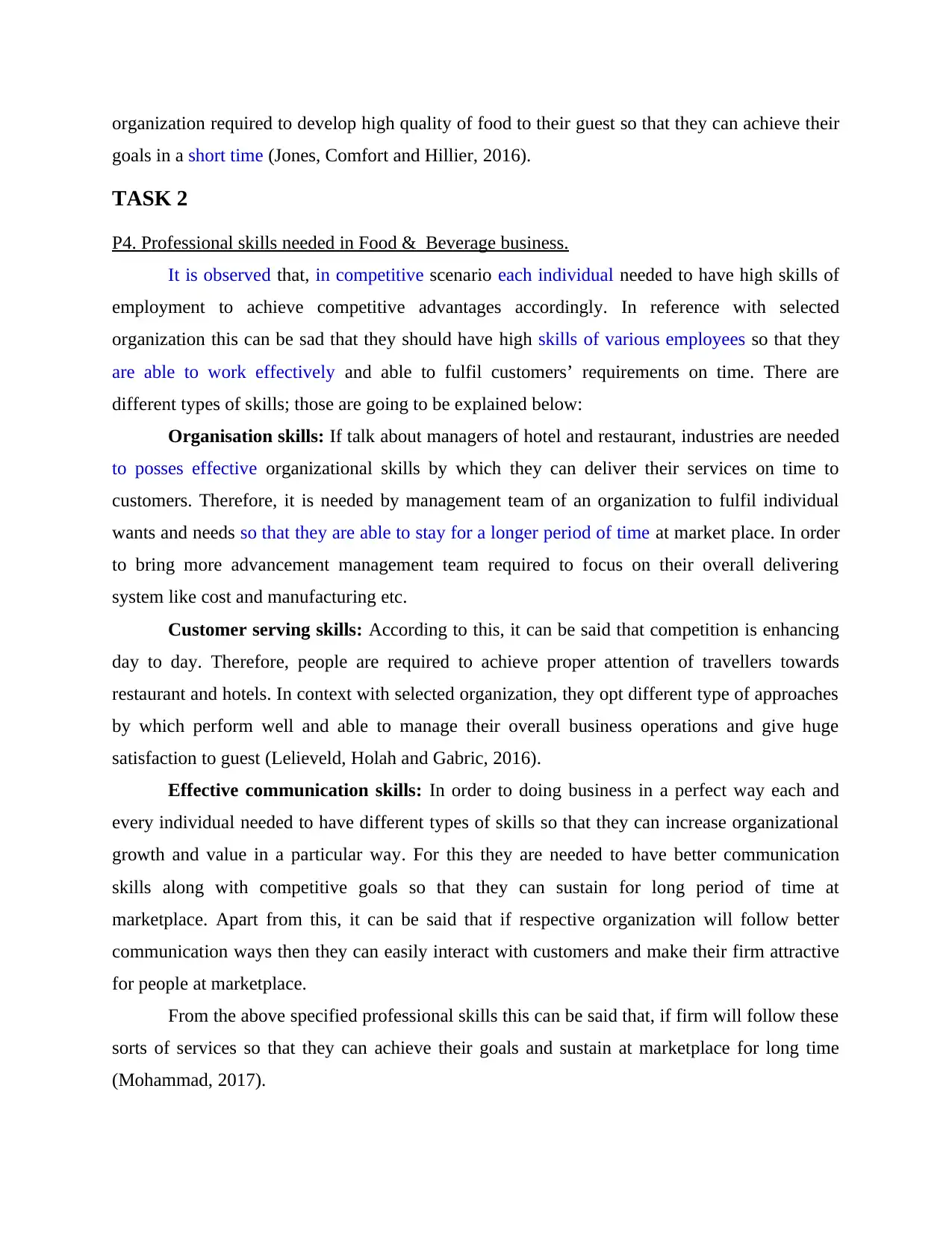
organization required to develop high quality of food to their guest so that they can achieve their
goals in a short time (Jones, Comfort and Hillier, 2016).
TASK 2
P4. Professional skills needed in Food & Beverage business.
It is observed that, in competitive scenario each individual needed to have high skills of
employment to achieve competitive advantages accordingly. In reference with selected
organization this can be sad that they should have high skills of various employees so that they
are able to work effectively and able to fulfil customers’ requirements on time. There are
different types of skills; those are going to be explained below:
Organisation skills: If talk about managers of hotel and restaurant, industries are needed
to posses effective organizational skills by which they can deliver their services on time to
customers. Therefore, it is needed by management team of an organization to fulfil individual
wants and needs so that they are able to stay for a longer period of time at market place. In order
to bring more advancement management team required to focus on their overall delivering
system like cost and manufacturing etc.
Customer serving skills: According to this, it can be said that competition is enhancing
day to day. Therefore, people are required to achieve proper attention of travellers towards
restaurant and hotels. In context with selected organization, they opt different type of approaches
by which perform well and able to manage their overall business operations and give huge
satisfaction to guest (Lelieveld, Holah and Gabric, 2016).
Effective communication skills: In order to doing business in a perfect way each and
every individual needed to have different types of skills so that they can increase organizational
growth and value in a particular way. For this they are needed to have better communication
skills along with competitive goals so that they can sustain for long period of time at
marketplace. Apart from this, it can be said that if respective organization will follow better
communication ways then they can easily interact with customers and make their firm attractive
for people at marketplace.
From the above specified professional skills this can be said that, if firm will follow these
sorts of services so that they can achieve their goals and sustain at marketplace for long time
(Mohammad, 2017).
goals in a short time (Jones, Comfort and Hillier, 2016).
TASK 2
P4. Professional skills needed in Food & Beverage business.
It is observed that, in competitive scenario each individual needed to have high skills of
employment to achieve competitive advantages accordingly. In reference with selected
organization this can be sad that they should have high skills of various employees so that they
are able to work effectively and able to fulfil customers’ requirements on time. There are
different types of skills; those are going to be explained below:
Organisation skills: If talk about managers of hotel and restaurant, industries are needed
to posses effective organizational skills by which they can deliver their services on time to
customers. Therefore, it is needed by management team of an organization to fulfil individual
wants and needs so that they are able to stay for a longer period of time at market place. In order
to bring more advancement management team required to focus on their overall delivering
system like cost and manufacturing etc.
Customer serving skills: According to this, it can be said that competition is enhancing
day to day. Therefore, people are required to achieve proper attention of travellers towards
restaurant and hotels. In context with selected organization, they opt different type of approaches
by which perform well and able to manage their overall business operations and give huge
satisfaction to guest (Lelieveld, Holah and Gabric, 2016).
Effective communication skills: In order to doing business in a perfect way each and
every individual needed to have different types of skills so that they can increase organizational
growth and value in a particular way. For this they are needed to have better communication
skills along with competitive goals so that they can sustain for long period of time at
marketplace. Apart from this, it can be said that if respective organization will follow better
communication ways then they can easily interact with customers and make their firm attractive
for people at marketplace.
From the above specified professional skills this can be said that, if firm will follow these
sorts of services so that they can achieve their goals and sustain at marketplace for long time
(Mohammad, 2017).
⊘ This is a preview!⊘
Do you want full access?
Subscribe today to unlock all pages.

Trusted by 1+ million students worldwide
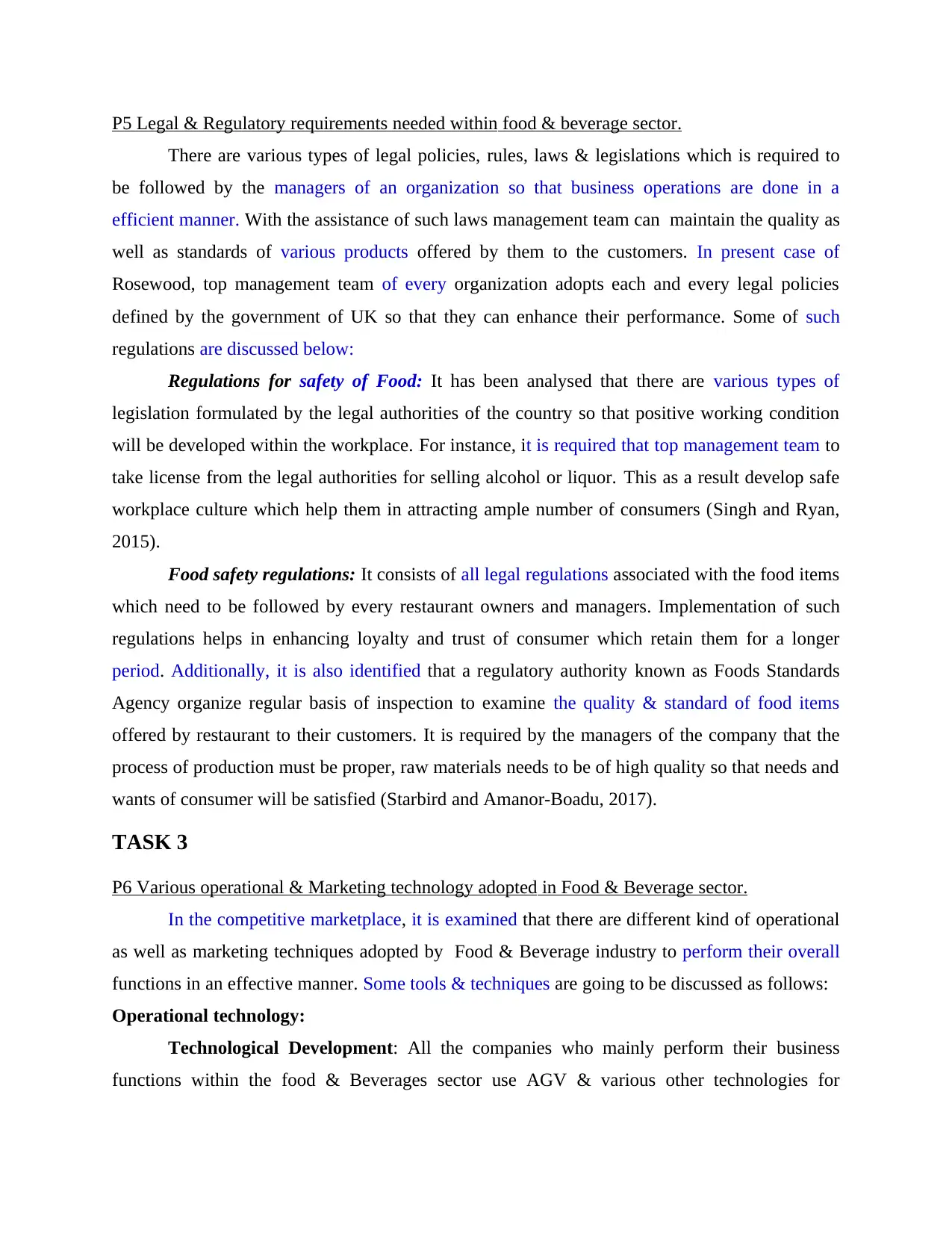
P5 Legal & Regulatory requirements needed within food & beverage sector.
There are various types of legal policies, rules, laws & legislations which is required to
be followed by the managers of an organization so that business operations are done in a
efficient manner. With the assistance of such laws management team can maintain the quality as
well as standards of various products offered by them to the customers. In present case of
Rosewood, top management team of every organization adopts each and every legal policies
defined by the government of UK so that they can enhance their performance. Some of such
regulations are discussed below:
Regulations for safety of Food: It has been analysed that there are various types of
legislation formulated by the legal authorities of the country so that positive working condition
will be developed within the workplace. For instance, it is required that top management team to
take license from the legal authorities for selling alcohol or liquor. This as a result develop safe
workplace culture which help them in attracting ample number of consumers (Singh and Ryan,
2015).
Food safety regulations: It consists of all legal regulations associated with the food items
which need to be followed by every restaurant owners and managers. Implementation of such
regulations helps in enhancing loyalty and trust of consumer which retain them for a longer
period. Additionally, it is also identified that a regulatory authority known as Foods Standards
Agency organize regular basis of inspection to examine the quality & standard of food items
offered by restaurant to their customers. It is required by the managers of the company that the
process of production must be proper, raw materials needs to be of high quality so that needs and
wants of consumer will be satisfied (Starbird and Amanor-Boadu, 2017).
TASK 3
P6 Various operational & Marketing technology adopted in Food & Beverage sector.
In the competitive marketplace, it is examined that there are different kind of operational
as well as marketing techniques adopted by Food & Beverage industry to perform their overall
functions in an effective manner. Some tools & techniques are going to be discussed as follows:
Operational technology:
Technological Development: All the companies who mainly perform their business
functions within the food & Beverages sector use AGV & various other technologies for
There are various types of legal policies, rules, laws & legislations which is required to
be followed by the managers of an organization so that business operations are done in a
efficient manner. With the assistance of such laws management team can maintain the quality as
well as standards of various products offered by them to the customers. In present case of
Rosewood, top management team of every organization adopts each and every legal policies
defined by the government of UK so that they can enhance their performance. Some of such
regulations are discussed below:
Regulations for safety of Food: It has been analysed that there are various types of
legislation formulated by the legal authorities of the country so that positive working condition
will be developed within the workplace. For instance, it is required that top management team to
take license from the legal authorities for selling alcohol or liquor. This as a result develop safe
workplace culture which help them in attracting ample number of consumers (Singh and Ryan,
2015).
Food safety regulations: It consists of all legal regulations associated with the food items
which need to be followed by every restaurant owners and managers. Implementation of such
regulations helps in enhancing loyalty and trust of consumer which retain them for a longer
period. Additionally, it is also identified that a regulatory authority known as Foods Standards
Agency organize regular basis of inspection to examine the quality & standard of food items
offered by restaurant to their customers. It is required by the managers of the company that the
process of production must be proper, raw materials needs to be of high quality so that needs and
wants of consumer will be satisfied (Starbird and Amanor-Boadu, 2017).
TASK 3
P6 Various operational & Marketing technology adopted in Food & Beverage sector.
In the competitive marketplace, it is examined that there are different kind of operational
as well as marketing techniques adopted by Food & Beverage industry to perform their overall
functions in an effective manner. Some tools & techniques are going to be discussed as follows:
Operational technology:
Technological Development: All the companies who mainly perform their business
functions within the food & Beverages sector use AGV & various other technologies for
Paraphrase This Document
Need a fresh take? Get an instant paraphrase of this document with our AI Paraphraser
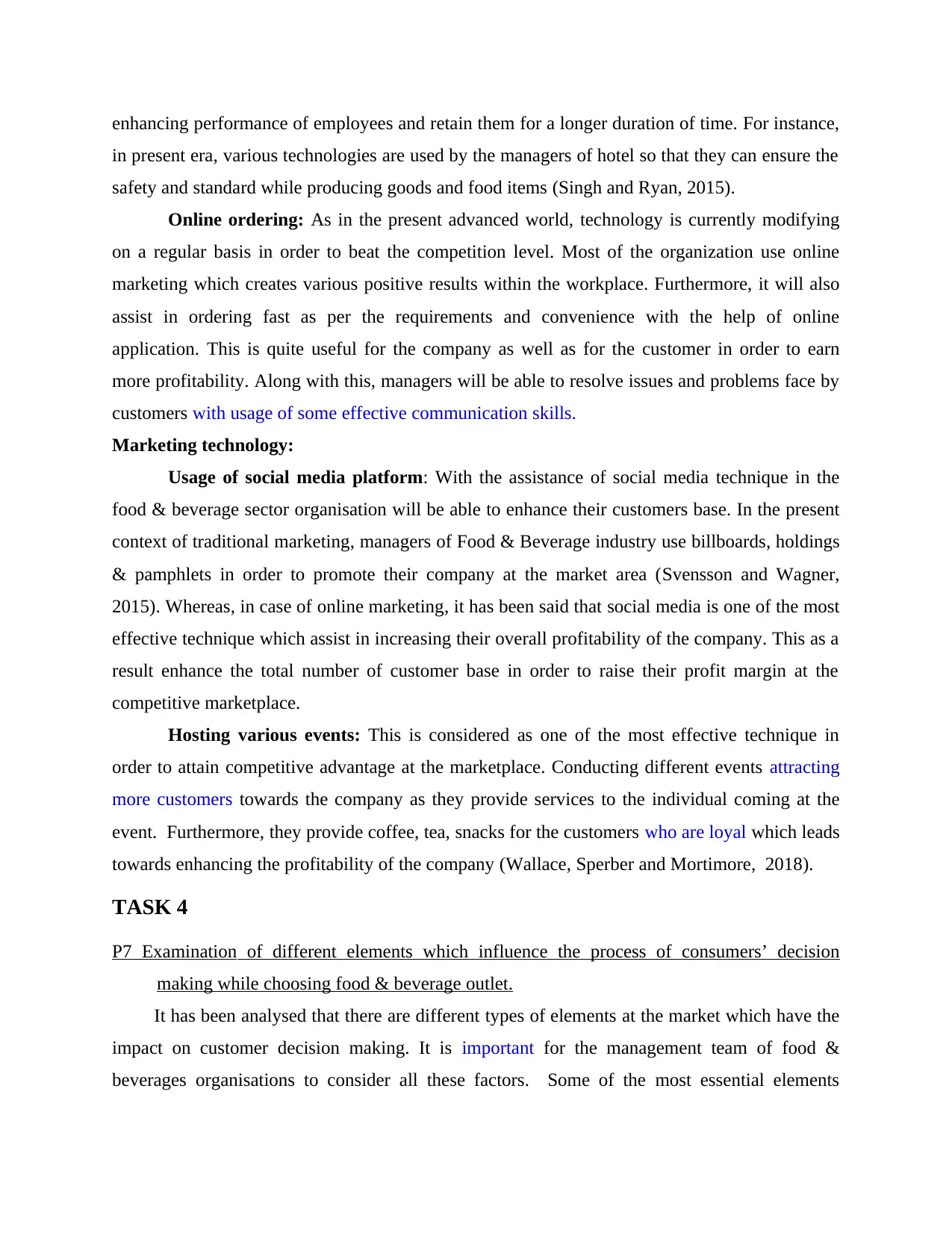
enhancing performance of employees and retain them for a longer duration of time. For instance,
in present era, various technologies are used by the managers of hotel so that they can ensure the
safety and standard while producing goods and food items (Singh and Ryan, 2015).
Online ordering: As in the present advanced world, technology is currently modifying
on a regular basis in order to beat the competition level. Most of the organization use online
marketing which creates various positive results within the workplace. Furthermore, it will also
assist in ordering fast as per the requirements and convenience with the help of online
application. This is quite useful for the company as well as for the customer in order to earn
more profitability. Along with this, managers will be able to resolve issues and problems face by
customers with usage of some effective communication skills.
Marketing technology:
Usage of social media platform: With the assistance of social media technique in the
food & beverage sector organisation will be able to enhance their customers base. In the present
context of traditional marketing, managers of Food & Beverage industry use billboards, holdings
& pamphlets in order to promote their company at the market area (Svensson and Wagner,
2015). Whereas, in case of online marketing, it has been said that social media is one of the most
effective technique which assist in increasing their overall profitability of the company. This as a
result enhance the total number of customer base in order to raise their profit margin at the
competitive marketplace.
Hosting various events: This is considered as one of the most effective technique in
order to attain competitive advantage at the marketplace. Conducting different events attracting
more customers towards the company as they provide services to the individual coming at the
event. Furthermore, they provide coffee, tea, snacks for the customers who are loyal which leads
towards enhancing the profitability of the company (Wallace, Sperber and Mortimore, 2018).
TASK 4
P7 Examination of different elements which influence the process of consumers’ decision
making while choosing food & beverage outlet.
It has been analysed that there are different types of elements at the market which have the
impact on customer decision making. It is important for the management team of food &
beverages organisations to consider all these factors. Some of the most essential elements
in present era, various technologies are used by the managers of hotel so that they can ensure the
safety and standard while producing goods and food items (Singh and Ryan, 2015).
Online ordering: As in the present advanced world, technology is currently modifying
on a regular basis in order to beat the competition level. Most of the organization use online
marketing which creates various positive results within the workplace. Furthermore, it will also
assist in ordering fast as per the requirements and convenience with the help of online
application. This is quite useful for the company as well as for the customer in order to earn
more profitability. Along with this, managers will be able to resolve issues and problems face by
customers with usage of some effective communication skills.
Marketing technology:
Usage of social media platform: With the assistance of social media technique in the
food & beverage sector organisation will be able to enhance their customers base. In the present
context of traditional marketing, managers of Food & Beverage industry use billboards, holdings
& pamphlets in order to promote their company at the market area (Svensson and Wagner,
2015). Whereas, in case of online marketing, it has been said that social media is one of the most
effective technique which assist in increasing their overall profitability of the company. This as a
result enhance the total number of customer base in order to raise their profit margin at the
competitive marketplace.
Hosting various events: This is considered as one of the most effective technique in
order to attain competitive advantage at the marketplace. Conducting different events attracting
more customers towards the company as they provide services to the individual coming at the
event. Furthermore, they provide coffee, tea, snacks for the customers who are loyal which leads
towards enhancing the profitability of the company (Wallace, Sperber and Mortimore, 2018).
TASK 4
P7 Examination of different elements which influence the process of consumers’ decision
making while choosing food & beverage outlet.
It has been analysed that there are different types of elements at the market which have the
impact on customer decision making. It is important for the management team of food &
beverages organisations to consider all these factors. Some of the most essential elements
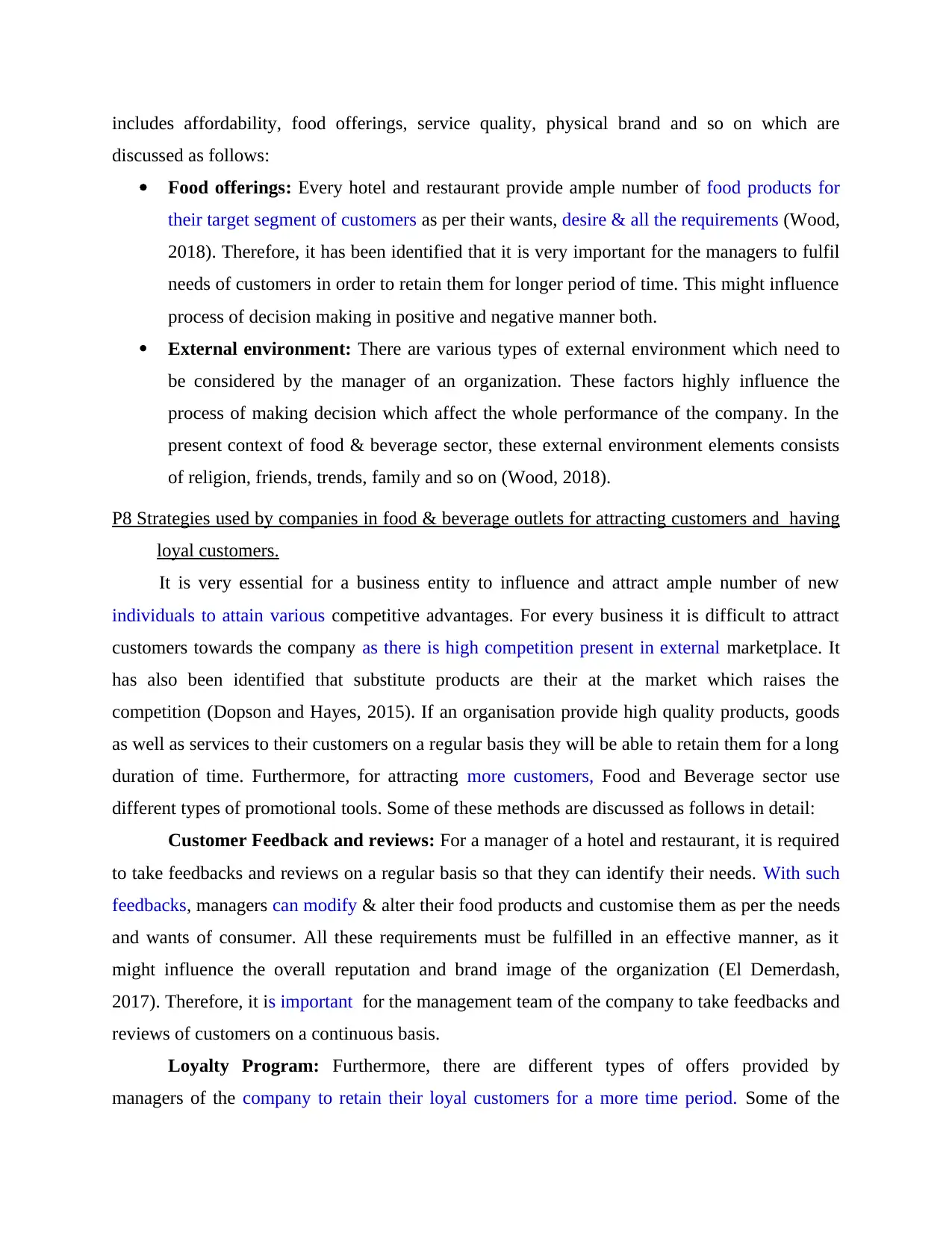
includes affordability, food offerings, service quality, physical brand and so on which are
discussed as follows:
Food offerings: Every hotel and restaurant provide ample number of food products for
their target segment of customers as per their wants, desire & all the requirements (Wood,
2018). Therefore, it has been identified that it is very important for the managers to fulfil
needs of customers in order to retain them for longer period of time. This might influence
process of decision making in positive and negative manner both.
External environment: There are various types of external environment which need to
be considered by the manager of an organization. These factors highly influence the
process of making decision which affect the whole performance of the company. In the
present context of food & beverage sector, these external environment elements consists
of religion, friends, trends, family and so on (Wood, 2018).
P8 Strategies used by companies in food & beverage outlets for attracting customers and having
loyal customers.
It is very essential for a business entity to influence and attract ample number of new
individuals to attain various competitive advantages. For every business it is difficult to attract
customers towards the company as there is high competition present in external marketplace. It
has also been identified that substitute products are their at the market which raises the
competition (Dopson and Hayes, 2015). If an organisation provide high quality products, goods
as well as services to their customers on a regular basis they will be able to retain them for a long
duration of time. Furthermore, for attracting more customers, Food and Beverage sector use
different types of promotional tools. Some of these methods are discussed as follows in detail:
Customer Feedback and reviews: For a manager of a hotel and restaurant, it is required
to take feedbacks and reviews on a regular basis so that they can identify their needs. With such
feedbacks, managers can modify & alter their food products and customise them as per the needs
and wants of consumer. All these requirements must be fulfilled in an effective manner, as it
might influence the overall reputation and brand image of the organization (El Demerdash,
2017). Therefore, it is important for the management team of the company to take feedbacks and
reviews of customers on a continuous basis.
Loyalty Program: Furthermore, there are different types of offers provided by
managers of the company to retain their loyal customers for a more time period. Some of the
discussed as follows:
Food offerings: Every hotel and restaurant provide ample number of food products for
their target segment of customers as per their wants, desire & all the requirements (Wood,
2018). Therefore, it has been identified that it is very important for the managers to fulfil
needs of customers in order to retain them for longer period of time. This might influence
process of decision making in positive and negative manner both.
External environment: There are various types of external environment which need to
be considered by the manager of an organization. These factors highly influence the
process of making decision which affect the whole performance of the company. In the
present context of food & beverage sector, these external environment elements consists
of religion, friends, trends, family and so on (Wood, 2018).
P8 Strategies used by companies in food & beverage outlets for attracting customers and having
loyal customers.
It is very essential for a business entity to influence and attract ample number of new
individuals to attain various competitive advantages. For every business it is difficult to attract
customers towards the company as there is high competition present in external marketplace. It
has also been identified that substitute products are their at the market which raises the
competition (Dopson and Hayes, 2015). If an organisation provide high quality products, goods
as well as services to their customers on a regular basis they will be able to retain them for a long
duration of time. Furthermore, for attracting more customers, Food and Beverage sector use
different types of promotional tools. Some of these methods are discussed as follows in detail:
Customer Feedback and reviews: For a manager of a hotel and restaurant, it is required
to take feedbacks and reviews on a regular basis so that they can identify their needs. With such
feedbacks, managers can modify & alter their food products and customise them as per the needs
and wants of consumer. All these requirements must be fulfilled in an effective manner, as it
might influence the overall reputation and brand image of the organization (El Demerdash,
2017). Therefore, it is important for the management team of the company to take feedbacks and
reviews of customers on a continuous basis.
Loyalty Program: Furthermore, there are different types of offers provided by
managers of the company to retain their loyal customers for a more time period. Some of the
⊘ This is a preview!⊘
Do you want full access?
Subscribe today to unlock all pages.

Trusted by 1+ million students worldwide
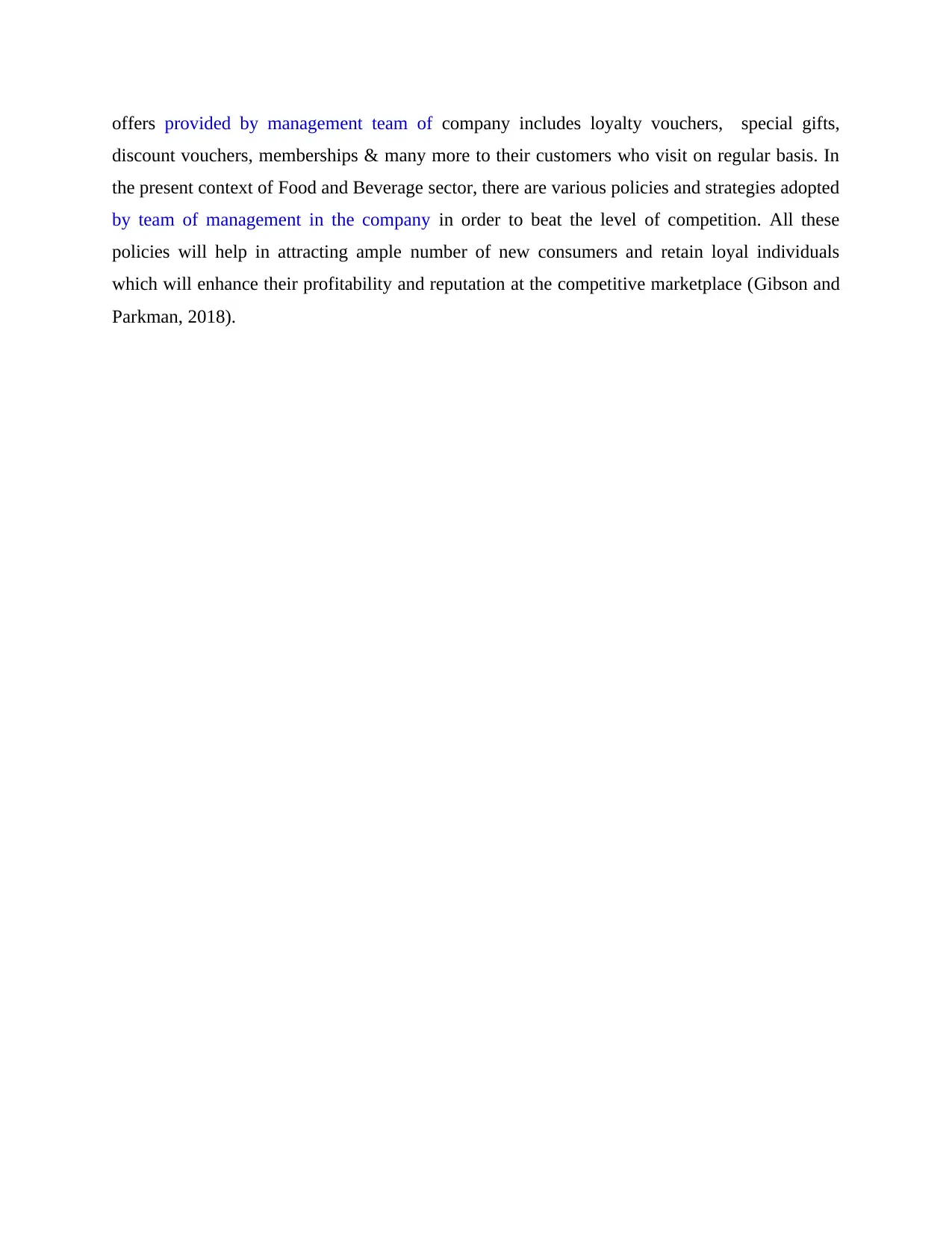
offers provided by management team of company includes loyalty vouchers, special gifts,
discount vouchers, memberships & many more to their customers who visit on regular basis. In
the present context of Food and Beverage sector, there are various policies and strategies adopted
by team of management in the company in order to beat the level of competition. All these
policies will help in attracting ample number of new consumers and retain loyal individuals
which will enhance their profitability and reputation at the competitive marketplace (Gibson and
Parkman, 2018).
discount vouchers, memberships & many more to their customers who visit on regular basis. In
the present context of Food and Beverage sector, there are various policies and strategies adopted
by team of management in the company in order to beat the level of competition. All these
policies will help in attracting ample number of new consumers and retain loyal individuals
which will enhance their profitability and reputation at the competitive marketplace (Gibson and
Parkman, 2018).
Paraphrase This Document
Need a fresh take? Get an instant paraphrase of this document with our AI Paraphraser
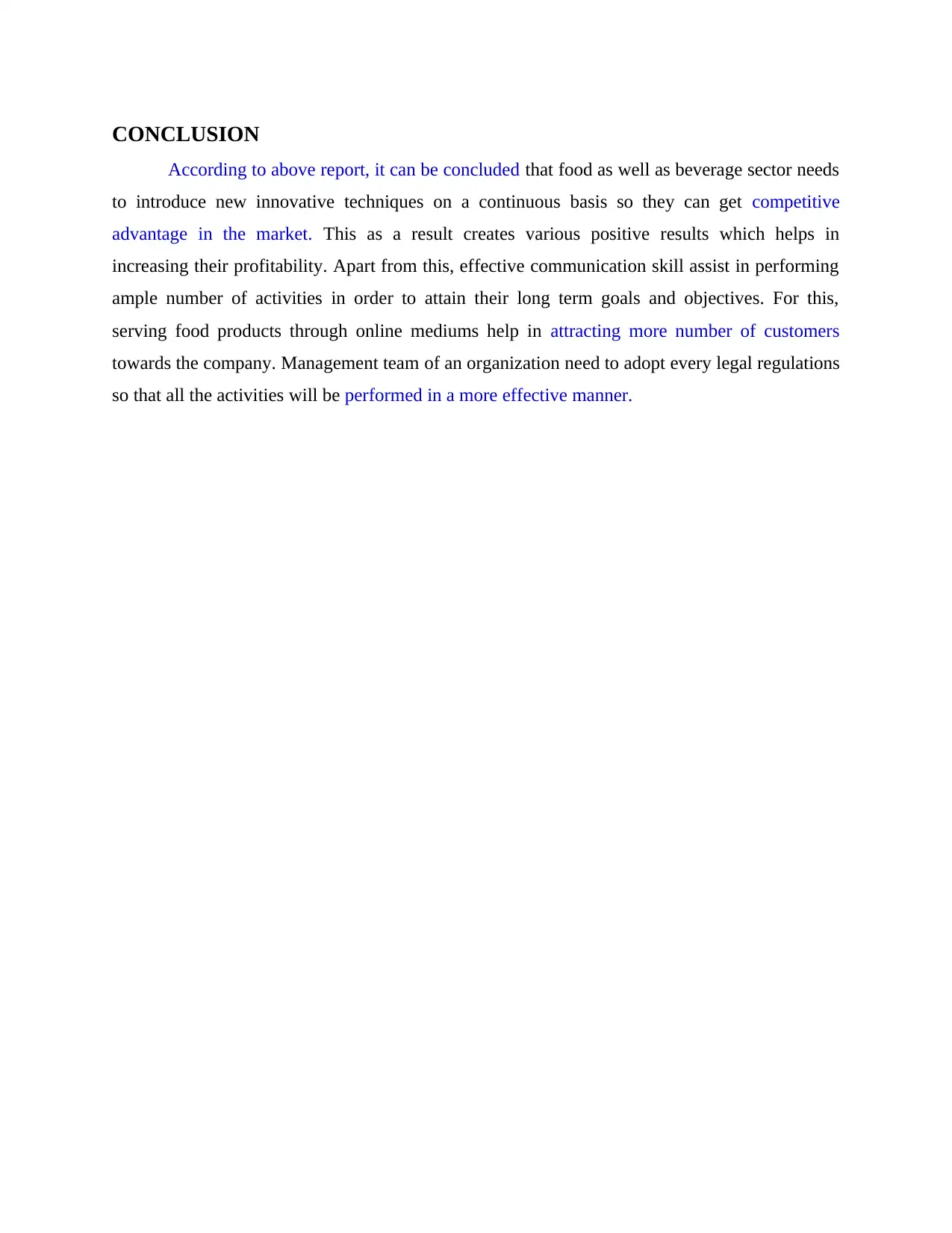
CONCLUSION
According to above report, it can be concluded that food as well as beverage sector needs
to introduce new innovative techniques on a continuous basis so they can get competitive
advantage in the market. This as a result creates various positive results which helps in
increasing their profitability. Apart from this, effective communication skill assist in performing
ample number of activities in order to attain their long term goals and objectives. For this,
serving food products through online mediums help in attracting more number of customers
towards the company. Management team of an organization need to adopt every legal regulations
so that all the activities will be performed in a more effective manner.
According to above report, it can be concluded that food as well as beverage sector needs
to introduce new innovative techniques on a continuous basis so they can get competitive
advantage in the market. This as a result creates various positive results which helps in
increasing their profitability. Apart from this, effective communication skill assist in performing
ample number of activities in order to attain their long term goals and objectives. For this,
serving food products through online mediums help in attracting more number of customers
towards the company. Management team of an organization need to adopt every legal regulations
so that all the activities will be performed in a more effective manner.
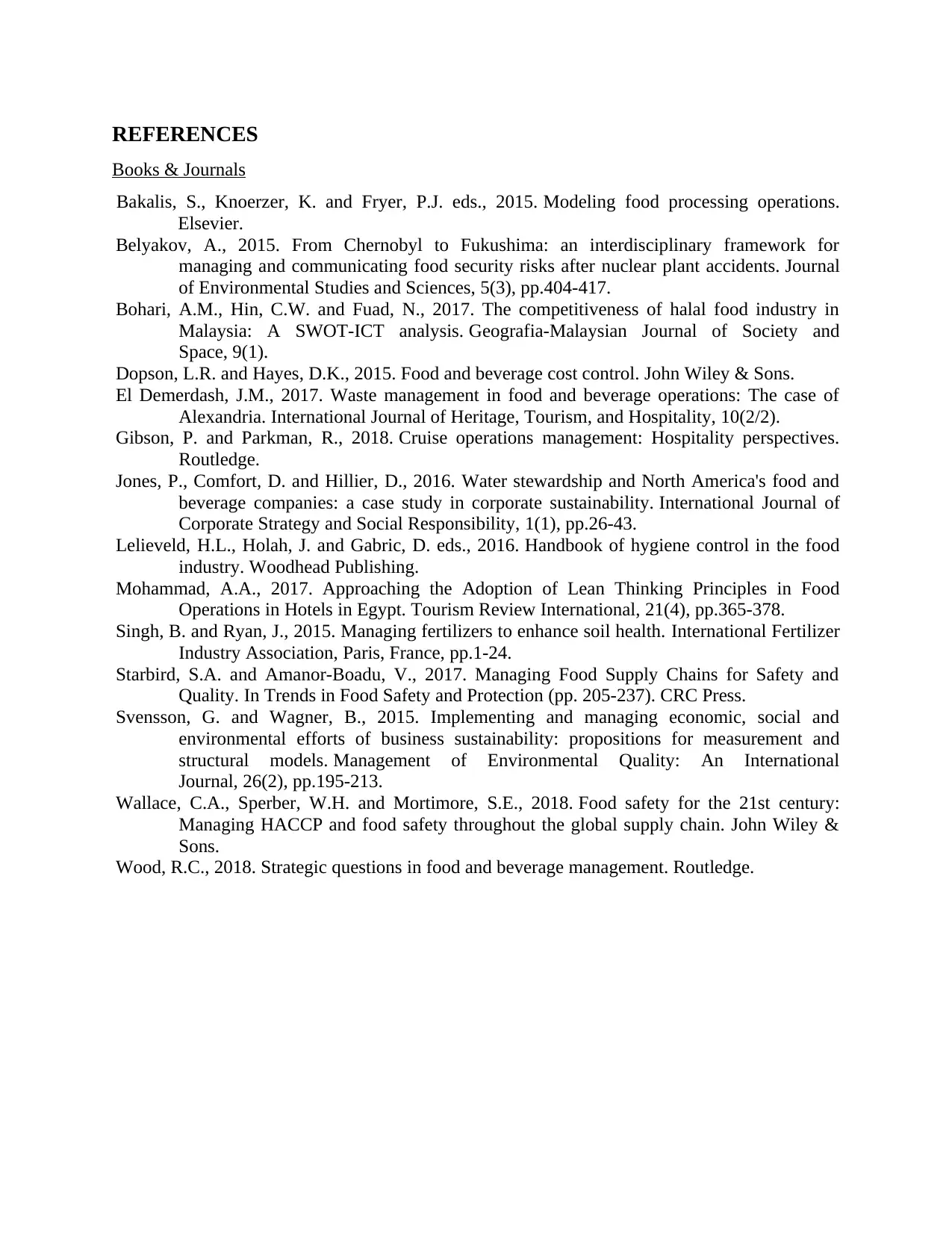
REFERENCES
Books & Journals
Bakalis, S., Knoerzer, K. and Fryer, P.J. eds., 2015. Modeling food processing operations.
Elsevier.
Belyakov, A., 2015. From Chernobyl to Fukushima: an interdisciplinary framework for
managing and communicating food security risks after nuclear plant accidents. Journal
of Environmental Studies and Sciences, 5(3), pp.404-417.
Bohari, A.M., Hin, C.W. and Fuad, N., 2017. The competitiveness of halal food industry in
Malaysia: A SWOT-ICT analysis. Geografia-Malaysian Journal of Society and
Space, 9(1).
Dopson, L.R. and Hayes, D.K., 2015. Food and beverage cost control. John Wiley & Sons.
El Demerdash, J.M., 2017. Waste management in food and beverage operations: The case of
Alexandria. International Journal of Heritage, Tourism, and Hospitality, 10(2/2).
Gibson, P. and Parkman, R., 2018. Cruise operations management: Hospitality perspectives.
Routledge.
Jones, P., Comfort, D. and Hillier, D., 2016. Water stewardship and North America's food and
beverage companies: a case study in corporate sustainability. International Journal of
Corporate Strategy and Social Responsibility, 1(1), pp.26-43.
Lelieveld, H.L., Holah, J. and Gabric, D. eds., 2016. Handbook of hygiene control in the food
industry. Woodhead Publishing.
Mohammad, A.A., 2017. Approaching the Adoption of Lean Thinking Principles in Food
Operations in Hotels in Egypt. Tourism Review International, 21(4), pp.365-378.
Singh, B. and Ryan, J., 2015. Managing fertilizers to enhance soil health. International Fertilizer
Industry Association, Paris, France, pp.1-24.
Starbird, S.A. and Amanor-Boadu, V., 2017. Managing Food Supply Chains for Safety and
Quality. In Trends in Food Safety and Protection (pp. 205-237). CRC Press.
Svensson, G. and Wagner, B., 2015. Implementing and managing economic, social and
environmental efforts of business sustainability: propositions for measurement and
structural models. Management of Environmental Quality: An International
Journal, 26(2), pp.195-213.
Wallace, C.A., Sperber, W.H. and Mortimore, S.E., 2018. Food safety for the 21st century:
Managing HACCP and food safety throughout the global supply chain. John Wiley &
Sons.
Wood, R.C., 2018. Strategic questions in food and beverage management. Routledge.
Books & Journals
Bakalis, S., Knoerzer, K. and Fryer, P.J. eds., 2015. Modeling food processing operations.
Elsevier.
Belyakov, A., 2015. From Chernobyl to Fukushima: an interdisciplinary framework for
managing and communicating food security risks after nuclear plant accidents. Journal
of Environmental Studies and Sciences, 5(3), pp.404-417.
Bohari, A.M., Hin, C.W. and Fuad, N., 2017. The competitiveness of halal food industry in
Malaysia: A SWOT-ICT analysis. Geografia-Malaysian Journal of Society and
Space, 9(1).
Dopson, L.R. and Hayes, D.K., 2015. Food and beverage cost control. John Wiley & Sons.
El Demerdash, J.M., 2017. Waste management in food and beverage operations: The case of
Alexandria. International Journal of Heritage, Tourism, and Hospitality, 10(2/2).
Gibson, P. and Parkman, R., 2018. Cruise operations management: Hospitality perspectives.
Routledge.
Jones, P., Comfort, D. and Hillier, D., 2016. Water stewardship and North America's food and
beverage companies: a case study in corporate sustainability. International Journal of
Corporate Strategy and Social Responsibility, 1(1), pp.26-43.
Lelieveld, H.L., Holah, J. and Gabric, D. eds., 2016. Handbook of hygiene control in the food
industry. Woodhead Publishing.
Mohammad, A.A., 2017. Approaching the Adoption of Lean Thinking Principles in Food
Operations in Hotels in Egypt. Tourism Review International, 21(4), pp.365-378.
Singh, B. and Ryan, J., 2015. Managing fertilizers to enhance soil health. International Fertilizer
Industry Association, Paris, France, pp.1-24.
Starbird, S.A. and Amanor-Boadu, V., 2017. Managing Food Supply Chains for Safety and
Quality. In Trends in Food Safety and Protection (pp. 205-237). CRC Press.
Svensson, G. and Wagner, B., 2015. Implementing and managing economic, social and
environmental efforts of business sustainability: propositions for measurement and
structural models. Management of Environmental Quality: An International
Journal, 26(2), pp.195-213.
Wallace, C.A., Sperber, W.H. and Mortimore, S.E., 2018. Food safety for the 21st century:
Managing HACCP and food safety throughout the global supply chain. John Wiley &
Sons.
Wood, R.C., 2018. Strategic questions in food and beverage management. Routledge.
⊘ This is a preview!⊘
Do you want full access?
Subscribe today to unlock all pages.

Trusted by 1+ million students worldwide
1 out of 12
Related Documents
Your All-in-One AI-Powered Toolkit for Academic Success.
+13062052269
info@desklib.com
Available 24*7 on WhatsApp / Email
![[object Object]](/_next/static/media/star-bottom.7253800d.svg)
Unlock your academic potential
Copyright © 2020–2025 A2Z Services. All Rights Reserved. Developed and managed by ZUCOL.





